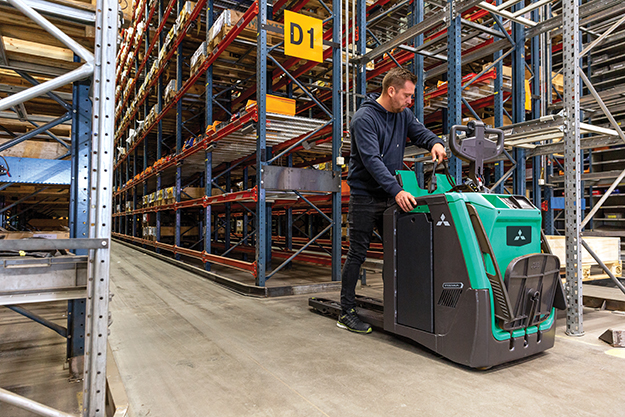Even if a forklift is designed with utmost safety and ergonomics in mind, it still possesses the potential to be a hazardous tool if not operated properly. While most businesses involved in materials handling have safety policies in place, it is crucial to prioritise safety in a busy and fast-paced warehouse environment.
Thankfully, by adhering closely to these fundamental guidelines and avoiding potentially dangerous practices, warehouse safety can be significantly enhanced.
Forklift training
Proper training for forklift drivers is absolutely essential (for further guidance read L117 HSE Operator Approved Code of Practice). Training not only helps to prevent accidents and fatalities involving operators and those working in the vicinity, but also reduces the risk of financial losses due to damaged goods. It is important to understand that forklift drivers who operate this machinery without proper training put themselves and everyone in the work area in immediate danger.
inspect the forklift before operating
Pre-use inspections ensure that every component is functioning properly and identify any potential issues before they become a problem. Not only do these inspections contribute to the safety of the forklift operators and those around them, but they also play a crucial role in prolonging the lifespan of the material handling equipment. By promptly addressing any issues that arise early on, maintenance can be performed efficiently and effectively to keep the forklift in optimal working condition.
always wear a seatbelt
While the HSE Operator Approved Code of Practice may not be legally binding, it is still important to consider the wearing of a seatbelt as it could potentially be used as evidence in any legal proceedings. Our recommendation is to always wear a seatbelt unless a risk assessment specifically states otherwise.
It is a legal requirement to wear a seatbelt when operating a Forklift Truck on public highways. This requirement is subject to the Road Traffic Act 1988.
DO NOT ALLOW ANYONE ON THE FORKLIFT DURING OPERATION
It is absolutely prohibited for anyone other than the driver to ride on a forklift truck under any circumstances. The driver should be the sole occupant of the forklift when it is in operation.
AVOID THE ELEVATED PORTION OF THE FORKLIFT
Remaining vigilant while operating forklifts is crucial to prevent accidents, even in situations that may occur unintentionally For example, do not allow a person to stand below elevated forks, as it could lead to serious injuries if the forks are lowered or if any items fall from the load. Therefore, it is always essential to maintain a safe distance to ensure everyone's wellbeing.
AVOID TRANSPORTING THE LOAD ABOVE THE SAFE HEIGHT LIMIT
In order to optimise the visibility of forklift drivers, many modern forklifts are purposefully designed to provide a clear view through the mast. However, this advantage can be negated if the load is raised too high, obstructing the driver's line of sight. Not only does this compromise the driver's safety, but it also poses a risk to others in the warehouse.
Additionally, operating a forklift with an elevated load can jeopardise the stability of the truck, making it more susceptible to tipping over, especially during cornering manoeuvres.
DO NOT ALLOW UNAUTHORIZED PERSONNEL TO RIDE ON THE FORKLIFT
While some order picking trucks are specifically designed to lift individuals to reach high shelves in a warehouse, it's important to note that other forklifts are not intended for this purpose. Therefore, it is crucial to never use the forks of a forklift to lift anything other than a proper unit load. Lifting a person with the forks of a truck can have fatal consequences, not to mention it goes against health and safety regulations. If there is a need to lift a person using a standard forklift, there are platform attachments available. These attachments, also known as cages, lifting platforms, or man baskets, are securely fixed to the forks and provide a safe means of lifting individuals.
DO NOT exceed the truck lift capacity
Attempting to exceed the designated weight capacity of a forklift may seem like a time-saving solution, but it is strongly discouraged. This dangerous practice not only increases the risk of damage and breakdowns, leading to costly downtime and repairs, but it also poses a significant threat to safety. By adhering to the specified lift capacity, you can have peace of mind knowing that your forklift is operating safely and effectively.
REMOVE KEY FROM IGNITION/LOG OFF WHEN LEAVING TRUCK
It may slip your mind, but it is crucial for drivers to take precautions to prevent anyone else from starting the truck when they are not present. Depending on the type of forklift, this may involve removing the key from the ignition or logging off through the truck's computer system. By doing so, it ensures that only trained and authorised individuals can operate the truck, minimising the risk of safety issues arising.
Establishing a culture of safety within your materials handling operation may require some time and effort, but the rewards are well worth it. If you would like to have a handy visual reminder of these essential safety tips, we have you covered.
Simply click the button below and fill out the form to receive a customised safety poster that you can proudly display in your workplace.
To find out more about Mitsubishi Forklift Trucks, call the Greenline on 0845 3713048 or email info@mitsubishi-forklift.co.uk




